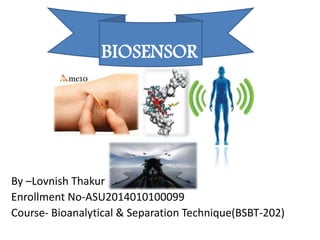
What is a biosensor
- 1. BIOSENSOR By –Lovnish Thakur Enrollment No-ASU2014010100099 Course- Bioanalytical & Separation Technique(BSBT-202)
- 2. WHAT IS A BIOSENSOR? Biosensors are analytical tools for the analysis of biomaterial samples to gain an understanding of their biocomposition, structure and function by converting a biological response into a measurable response.
- 3. FATHER OF BIOSENSORS Professor Leland C Clark
- 4. COMPONENTS
- 6. THE ANALYTE Molecule which do you want to detect • Protein, toxin, peptide, vitamin, sugar, metal ion
- 7. BIORECEPTOR • The sensitive biological element-a biologically derived material or biomimetic component that interacts (binds or recognizes) the analyte under study.
- 8. TRANSDUCER • A transducer is more generally defined as a device which converts energy from one form to another.
- 9. ELECTRICAL INTERFACES The detector element (works in a physicochemical way; optical, piezoelectric, electrochemical, etc.) that transforms the signal resulting from the interaction of the analyte with the biological element into electrical signal form.
- 10. ELECTRONIC SYSTEM Combination of electronic devices i.e. Amplifier, signal processer and display device that are primarily responsible for the display of the results in a user-friendly way.
- 11. WORKING PRINCIPLE Analyte diffuses from the solution to the surface of the Biosensor Analyte reacts specifically & efficiently with the Biological Component of the Biosensor. This reaction changes the physicochemical properties of the transducer surface. This leads to a change in the optical/electronic properties of the transducer Surface. The change in the optical/electronic properties is measured/ converted into electrical signal, which is detected.
- 13. ADVANTAGES Highly Specific. Easy to Use, Durable. Require only Small Sample Volume. Rapid, Accurate, Stable & Sterilizable.
- 14. TYPES OF BIOSENSORS Electrochemical biosensor Optical biosensor Thermal biosensor Resonant biosensor Ion-sensitive biosensor
- 15. APPLICATIONS OF BIOSENSORS • Food Analysis • Study of biomolecules and their interaction • Drug Development • Crime detection • Medical diagnosis(both clinical and laboratory use) • Environmental field monitoring • Quality control • Industrial Process Control • Detection systems for biological warfare agents • Manufacturing of pharmaceuticals and replacement organs
- 17. EXAMPLE
- 18. Sucrose Biosensor Sucrose is an essential part of any fruit, so estimating the concentration of sucrose at different maturity levels could help in identifying the ripening parameters of fruits. Therefore, with regard to sucrose detection, electrodes made up of invertase, mutarotase and glucose oxidase and mediated tri-enzyme electrode based on sucrose phosphorylase and electrocatalytic oxidation of NADH, have been used. The sucrose sensor developed was based on the invertase, mutarotase and glucose oxidase reaction scheme
- 19. agridr.in
- 20. DNA-based piezoelectric biosensor • A DNA sequence with a few hundred base pairs usually possesses a sufficiently high molecular weight so that the mass increase caused by hybridization of a DNA-chain with its complimentary counterpart previously immobilized on the surface of a piezoelectric quartz crystal may be specifically correlated with the increase in the fundamental resonance frequency of the crystal.
- 21. Reference • www.pitt.edu/~super4/360137001/36421.ppt • http://www.cse.unt.edu/~smohanty/Publicati ons_Journals/2006/MohantyIEEEPotentials20 06Mar-Apr.pdf • en.wikipedia.org/wiki/Biosensor • http://www.sirebi.org/open/Intro_Biosensing. pdf